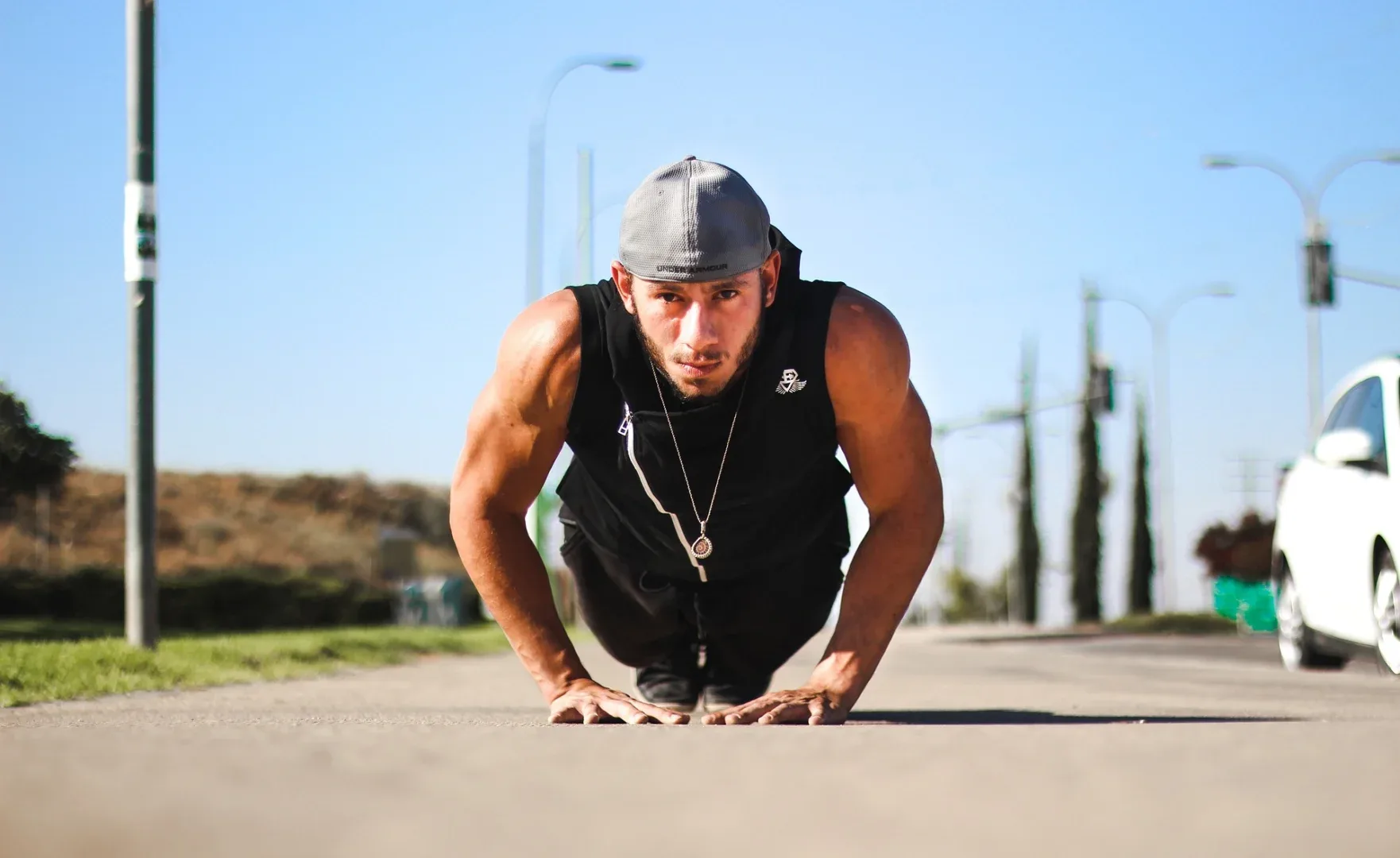Last Updated on October 15, 2025 by shawnshealth
Bodyweight exercises build strength, mobility, and endurance—no gear needed. Try 7 proven workouts to transform your fitness at any age!
Bodyweight Exercises: 7 Incredible Workouts to Transform Your Fitness
Bodyweight exercises are a fantastic way to build strength, improve flexibility, and boost cardiovascular health without the need for any equipment. Whether you’re at home, in a park, or traveling, these exercises can be performed anywhere, making them a versatile addition to any fitness routine. In this blog post, we’ll explore seven incredible bodyweight exercises that can transform your fitness. Each section will include a detailed description of the exercise, benefits, tips for proper form, and variations to keep your workouts interesting.
📚 New to Calisthenics or Want a Smarter Approach to Bodyweight Exercises? Before diving into today’s exercises, check out The Ultimate Calisthenics FAQ for a full breakdown of bodyweight training fundamentals. It covers technique, progression logic, recovery tips, and common mistakes—perfect for beginners and anyone looking to train smarter, not harder.
🎯 Who This Is For
This guide is perfect for:
- ✅ Beginners looking for simple, effective workouts without equipment
- ✅ Older adults seeking safe, strength-building routines they can do anywhere
- ✅ Anyone wanting to improve mobility, balance, and real-world strength
- ✅ Travelers or busy folks who need flexible, no-gym training options
- ✅ Lifelong movers ready to level up with smart, progression-based bodyweight training
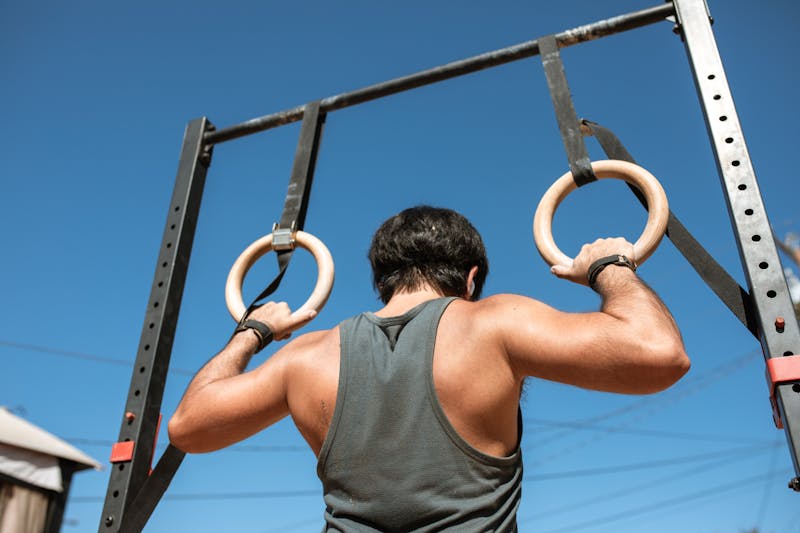
What Are the Core Principles of Bodyweight Strength Training?
- Uses bodyweight resistance to develop muscle and control
- Focuses on natural, functional movements
- Improves joint health and overall mobility
- Builds stability and balance without external equipment
How Does Progressive Overload Work Without Weights?
- Increase reps or sets over time to boost intensity
- Slow down movement for greater time under tension
- Change leverage (e.g., incline to flat to decline)
- Add holds or pauses to challenge strength and endurance
Why Is Proper Form Crucial in Calisthenics Fundamentals?
- Enhances muscle engagement and efficiency
- Prevents injury by reducing joint strain
- Builds better body awareness and posture
- Maximizes results from minimal movement
What Makes Bodyweight Exercises Effective for Functional Fitness?
- Trains multiple muscle groups together
- Improves coordination, agility, and real-world strength
- Encourages full range of motion in every rep
- Adapts easily to all fitness levels, including beginners
Table of Contents
Always consult your doctor before starting any new exercise program. The author is not responsible for injuries or health issues arising from the use of this information.
As an Amazon Associate, I earn from qualifying purchases. This means I may receive a commission if you purchase through links on this site, at no extra cost to you.
Why I Prefer Bodyweight Exercises
Bodyweight training is a form of strength and conditioning exercise that uses your own body as resistance—no equipment needed—to build muscle, improve mobility, and enhance overall fitness.
I have been working out with bodyweight exercises much of my life. I have worked with weights in many forms but keep coming back to bodyweight training. I will be the first to say that if you want the “easiest,” fastest, most effective way to pack on muscle and strength then go lift weights.
If you want a lean fit body that is super strong and extremely capable then you can achieve this using only bodyweight exercises and you can do it anywhere!
I have always had a hangup with weightlifting because I travel enough that I have never wanted to have to locate a gym, figure out the floor plan, and shovel out money just to get in a good workout. If I am cranking out pushups, bodyweight triceps extensions, one-arm bench dips, etc. at home then I want to be able to continue with that same workout when I’m not at home. I can get my exact workout done in any hotel room, or roadside park without having to change up what I’m doing.
I am 59 years old at the time of this writing. I see guys my age all the time who have problems doing a single pushup whereas I am cranking out several hundred in a single workout. Or they can’t do a dead-arm hang for more than 5 seconds whereas I am doing pullups and bodyweight rows a minimum of twice a week.
A more shocking thing I have encountered is that my kid’s friends can’t even begin to do 5 pushups and often struggle to get one! This is a sad commentary on our world today.
My point here is that bodyweight training is a fantastic way to gain strength and mobility. If you do it the “smart” way then you will gradually, over time, challenge yourself a little bit more on a regular basis until what used to be difficult (2 reps of pushups) is now easy and you are doing much more (15 reps of decline pushups). It doesn’t matter what age you are; you can always improve!
Happy training!
🎥 New to Bodyweight Training? Watch this quick video from MD Anderson Cancer Center for simple, safe movement tips—perfect for beginners or older adults looking to build strength and confidence without equipment.
Training Overview for Bodyweight Exercises
Now that you understand the key principles of bodyweight training, it’s time to put them into action. The following section outlines a variety of movements designed to build strength, control, and mobility using only your body. These exercises can be adapted for any fitness level and require no equipment—just your commitment and consistency.
How to Structure and Progress Your Bodyweight Workouts
Frequency:
- Aim for 3–5 sessions per week, depending on your goals and recovery ability
- Beginners can start with full-body sessions 2–3 times a week
Progression Tips:
- Increase reps, sets, or time under tension each week
- Advance to harder variations as you build strength
- Maintain proper form over chasing numbers
Reps and Sets Guidelines:
- Strength focus: 3–5 sets of 4–8 reps (with harder variations)
- Endurance focus: 2–4 sets of 10–20 reps
- Mobility or control: Slow, controlled reps with pauses or holds
Split Ideas:
- Full-body: Ideal for beginners or busy schedules (2–3x/week)
- Upper/Lower split: Alternate days for recovery (e.g., Mon–Upper, Tue–Lower)
- Push/Pull/Legs: For intermediate to advanced trainees training 5–6 days/week
Rest Days:
- Include 1–2 rest days per week, or active recovery like walking or stretching
This structure ensures steady progress, reduces risk of burnout, and allows for long-term gains using bodyweight alone.
🛒 Quick Tip: Looking for fitness gear? Browse top-rated calisthenics equipment on Amazon to power up your workouts fast 💪
As an Amazon Associate, I earn from qualifying purchases. This means I may receive a commission if you purchase through links on this site, at no extra cost to you.
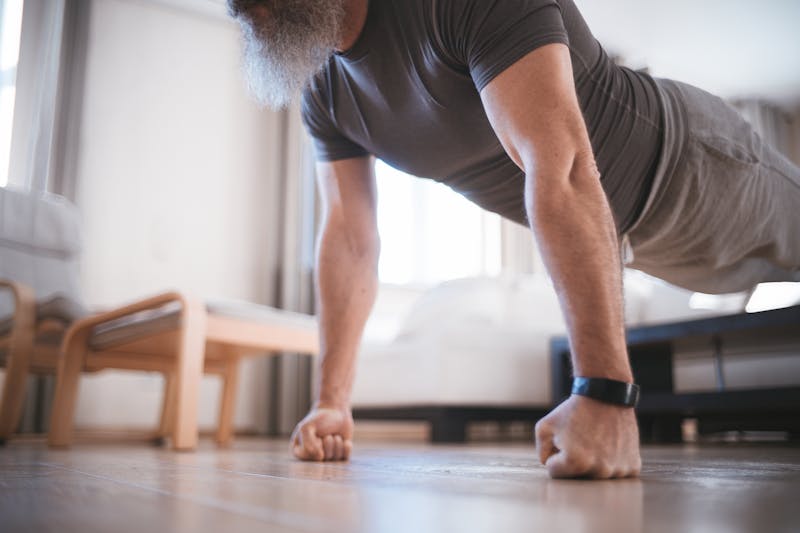
The Bodyweight Exercises
1. Push-Ups
Push-ups are a classic bodyweight exercise that targets the chest, shoulders, triceps, and core. They are great for building upper body strength and can be modified to suit all fitness levels.
How to Perform a Push-Up:
- Start in a high plank position with your hands placed slightly wider than shoulder-width apart.
- Lower your body until your chest nearly touches the floor, keeping your elbows at a 45-degree angle from your body.
- Push through your palms to return to the starting position.
Benefits:
- Strengthens the chest, shoulders, and triceps.
- Engages the core and improves stability.
- Can be modified for different fitness levels.
Tips:
- Keep your body in a straight line from head to heels.
- Engage your core to prevent your hips from sagging.
- Breathe in as you lower your body and breathe out as you push up.
Variations:
- Knee Push-Ups: Perform the push-up with your knees on the floor for an easier variation.
- Decline Push-Ups: Place your feet on an elevated surface to increase the difficulty.
- Diamond Push-Ups: Bring your hands close together to form a diamond shape, targeting the triceps more intensely.
🔁 Progression Tip: Start with knee or incline push-ups if needed, then gradually increase reps or switch to standard and decline variations. Once you can do 3 sets of 15 with good form, consider building toward 100 pushups in a row using a structured plan.
🔥 Want to Hit 100 Push-Ups in a Row? Check out my full guide on building push-up endurance the smart way. It’s packed with progression tips, form fixes, and a step-by-step plan to help you reach triple digits—whether you’re starting from 5 reps or 50.
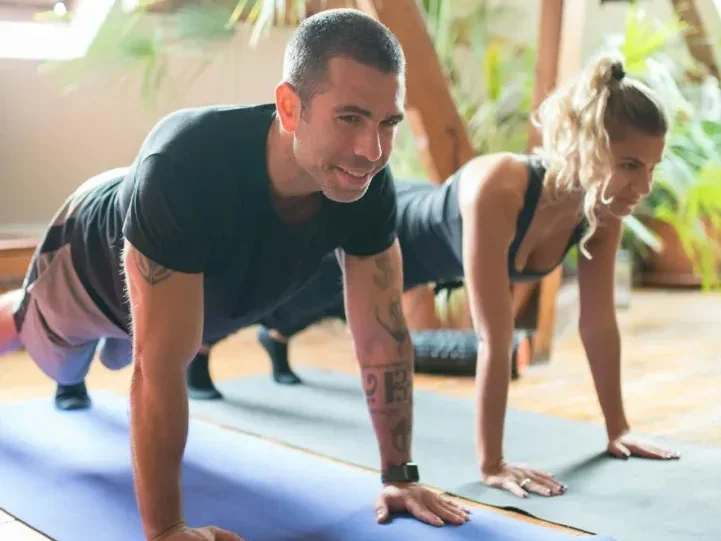
2. Squats
Squats are essential for building lower body strength, targeting the quads, hamstrings, glutes, and calves. They also engage the core and improve overall balance and coordination. As one of the foundational bodyweight exercises, squats are incredibly effective.
How to Perform a Squat:
- Stand with your feet shoulder-width apart, toes slightly turned out.
- Lower your hips back and down as if sitting into a chair, keeping your chest up and knees in line with your toes.
- Push through your heels to return to the starting position.
Benefits:
- Strengthens the lower body muscles.
- Enhances core stability.
- Improves balance and coordination.
Tips:
- Keep your chest up and back straight.
- Ensure your knees do not extend past your toes.
- Engage your core throughout the movement.
Variations:
- Jump Squats: Add a jump at the end of each squat for a plyometric challenge.
- Pistol Squats: Perform the squat on one leg, extending the other leg in front of you.
- Sumo Squats: Stand with your feet wider than shoulder-width and toes turned out to target the inner thighs.
🔁 Progression Tip: Begin with shallow squats or chair-assisted versions. As strength improves, increase depth and reps. Add jump squats or single-leg work once 3 sets of 20 feel comfortable and controlled.
🦵 Build Strong Legs—No Weights Needed Check out my article on Powerful Leg Exercises without using weights to discover seven effective moves that boost strength, balance, and mobility using just your body. Perfect for home workouts and progression-based training at any age.
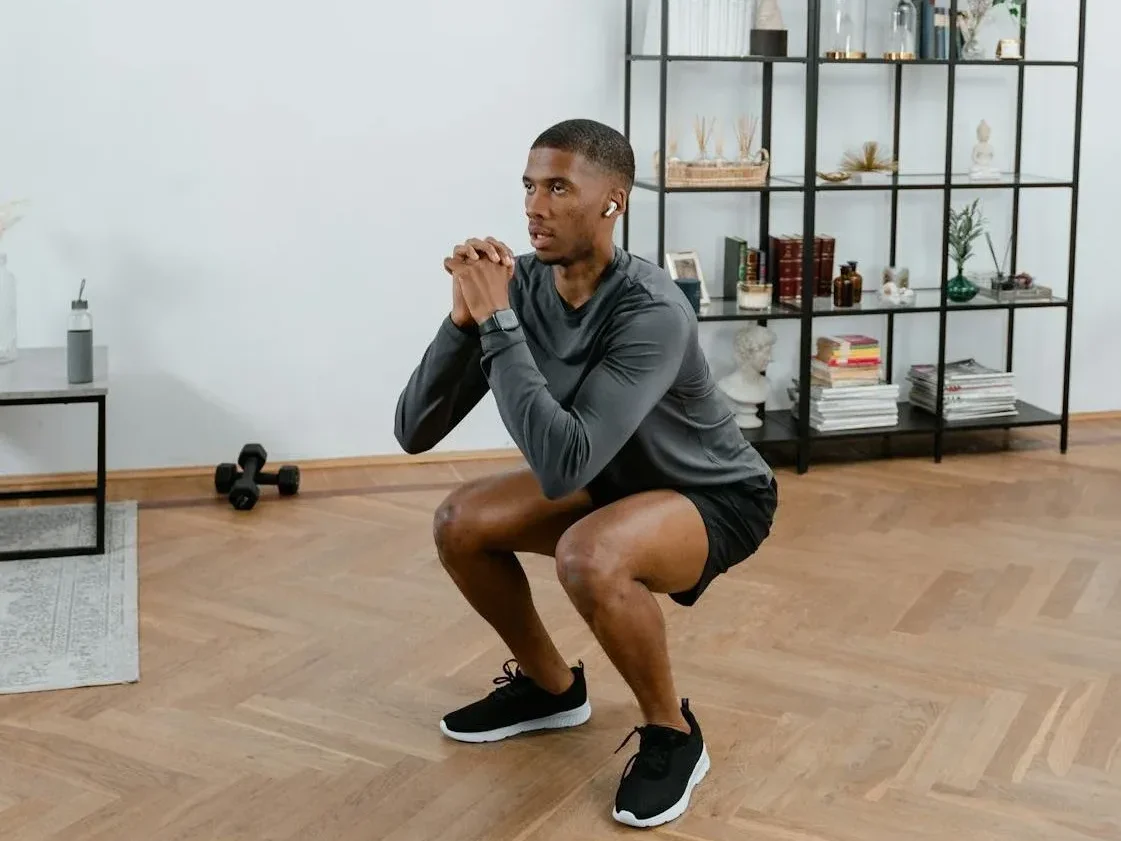
3. Planks
Planks are an excellent exercise for building core strength and stability. They also engage the shoulders, back, and glutes, making them a comprehensive full-body exercise. Among bodyweight exercises, planks are incredibly effective for core conditioning.
How to Perform a Plank:
- Start in a forearm plank position with your elbows directly under your shoulders and your body in a straight line from head to heels.
- Engage your core and glutes, and hold the position for as long as possible without compromising form.
Benefits:
- Strengthens the core, shoulders, and back.
- Improves posture and stability.
- Can be modified for different fitness levels.
Tips:
- Keep your body in a straight line and avoid letting your hips sag.
- Engage your core and glutes for better stability.
- Breathe steadily and deeply.
Variations:
- Side Planks: Shift your weight onto one forearm and stack your feet to target the obliques.
- Plank with Leg Lift: Lift one leg off the ground while maintaining the plank position to increase the challenge.
- Plank to Push-Up: Alternate between a forearm plank and a high plank for a dynamic core workout.
🔁 Progression Tip: Start with 15–30 seconds and build up to 60+ seconds over time. Add leg lifts, side planks, or dynamic transitions once static holds feel solid. Focus on form over duration to protect your lower back.
🧱 Boost Your Core in Just 15 Minutes Take a look at our 15-Minute Ab Workout article for a quick, effective routine that builds strength, stability, and confidence—perfect for older adults and anyone short on time but serious about results.
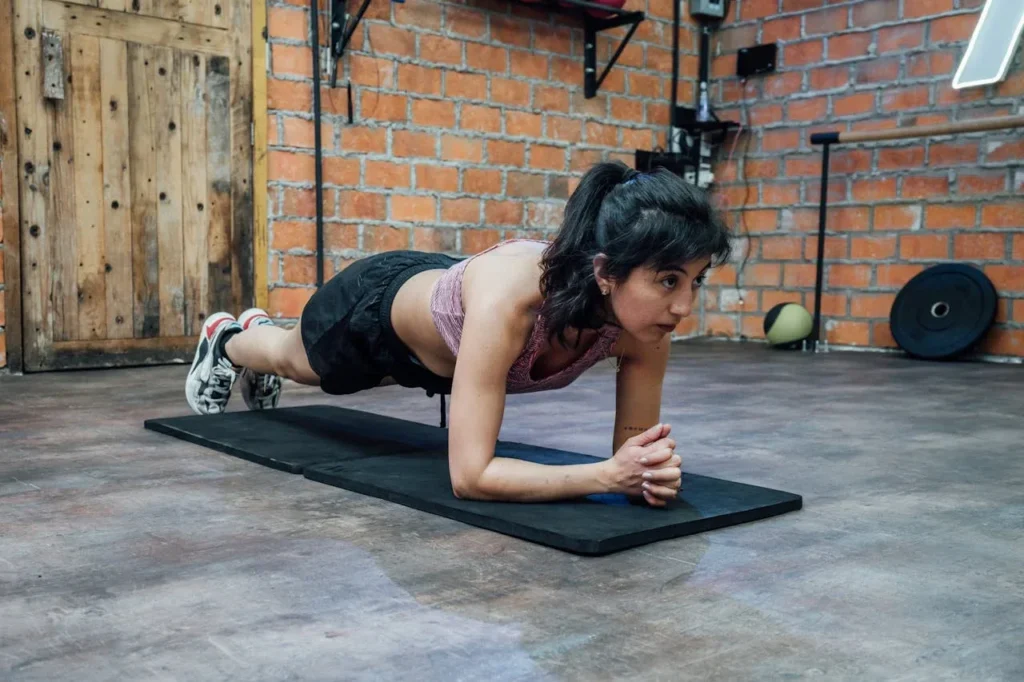
4. Lunges
Lunges are great for building lower body strength and improving balance. They target the quads, hamstrings, glutes, and calves, and can be performed in various directions to work different muscle groups. As versatile bodyweight exercises, lunges can be incorporated into any routine.
How to Perform a Lunge:
- Stand with your feet together.
- Step forward with one leg and lower your hips until both knees are bent at a 90-degree angle.
- Push through the front heel to return to the starting position.
Benefits:
- Strengthens the lower body muscles.
- Enhances balance and coordination.
- Can be performed in different directions for variety.
Tips:
- Keep your chest up and shoulders back.
- Ensure your front knee does not extend past your toes.
- Engage your core for better stability.
Variations:
- Reverse Lunges: Step backward instead of forward to change the focus on the muscles worked.
- Walking Lunges: Perform lunges while moving forward for an added balance challenge.
- Curtsy Lunges: Step one leg behind and across the other to target the inner thighs and glutes.
🔁 Progression Tip: Use a wall or chair for balance early on. Begin with stationary lunges, then progress to walking or reverse lunges. Increase reps or add a slight pause at the bottom to build control and strength.
🛠️ Want to Train Smarter? Check out my guide on Common Calisthenics Mistakes to avoid setbacks and make faster progress.
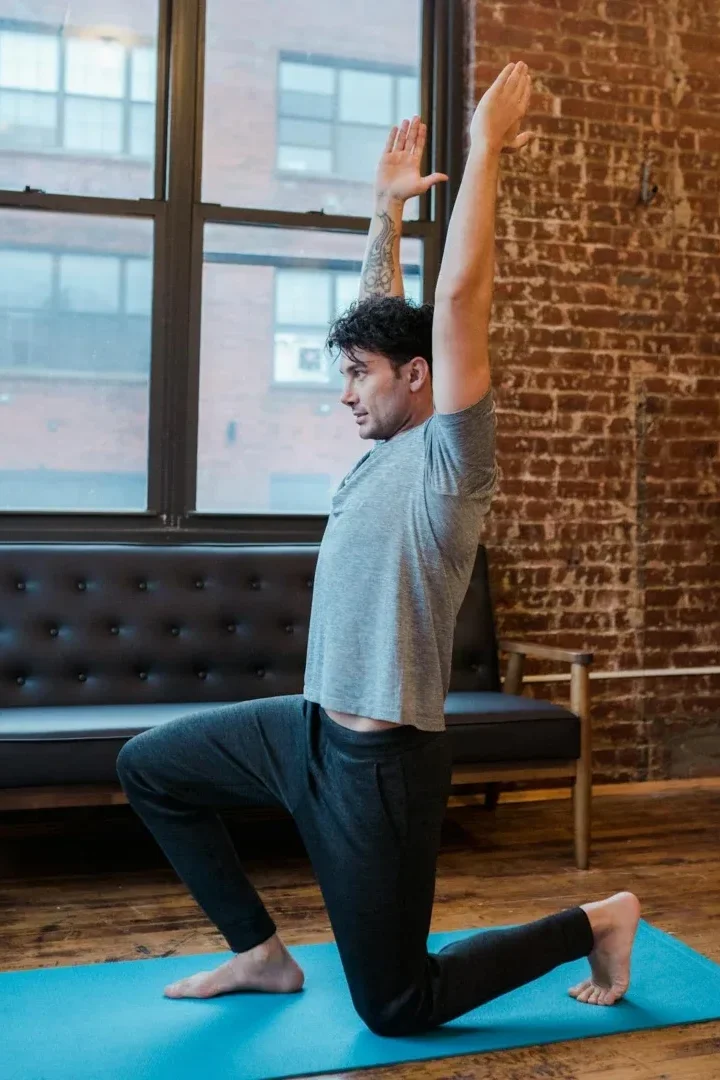
5. Burpees
Burpees are a high-intensity exercise that combines strength and cardio. They work the entire body, targeting the legs, core, chest, and shoulders, and are excellent for boosting cardiovascular fitness. Among bodyweight exercises, burpees are known for their ability to enhance overall fitness quickly.
How to Perform a Burpee:
- Start in a standing position.
- Drop into a squat and place your hands on the floor.
- Jump your feet back into a plank position.
- Perform a push-up.
- Jump your feet back to your hands, and explosively jump up to return to the standing position.
Benefits:
- Full-body workout that builds strength and cardio.
- Increases endurance and explosiveness.
- Can be modified for different fitness levels.
Tips:
- Perform each movement with controlled speed.
- Engage your core during the plank and push-up.
- Land softly during the jump to reduce impact on your joints.
Variations:
- Half Burpee: Omit the push-up for a slightly easier variation.
- Burpee Box Jump: Incorporate a box jump at the end for an added challenge.
- Burpee Tuck Jump: Add a tuck jump instead of a regular jump for increased intensity.
🔁 Progression Tip: Start with half burpees (no push-up or jump) and build up to full reps. Once you can do 10–15 with good form, try adding a tuck jump or box jump for extra intensity. Keep rest short to boost endurance.
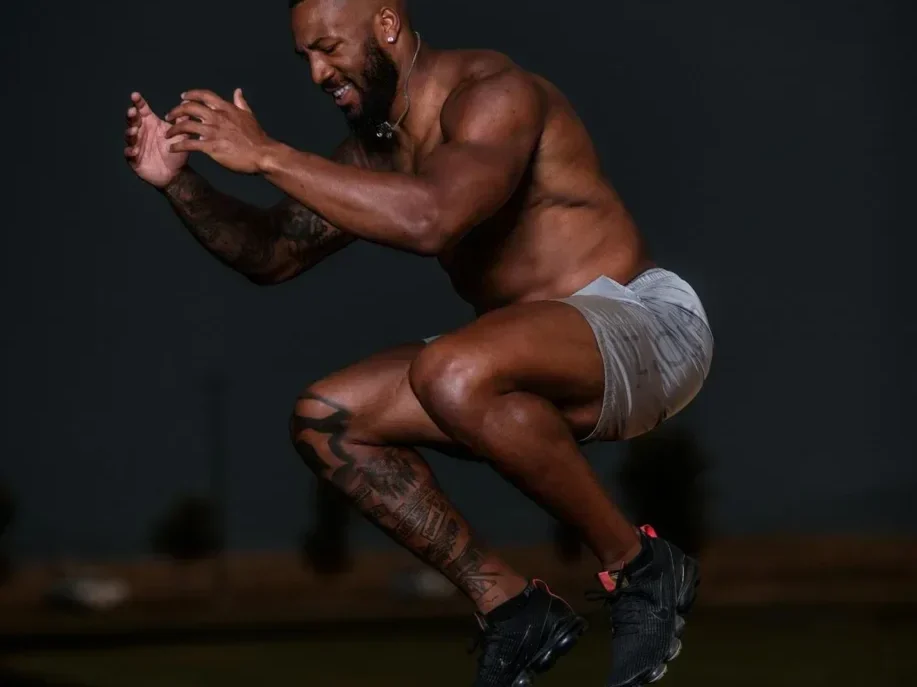
6. Mountain Climbers
Mountain climbers are a dynamic exercise that targets the core, shoulders, and legs. They are great for improving cardiovascular fitness and building core strength. Including mountain climbers in your bodyweight exercises routine can significantly enhance your endurance.
How to Perform Mountain Climbers:
- Start in a high plank position.
- Bring one knee towards your chest, then quickly switch legs, mimicking a running motion.
- Keep your core engaged and maintain a steady pace.
Benefits:
- Strengthens the core and upper body.
- Boosts cardiovascular fitness.
- Improves coordination and agility.
Tips:
- Keep your body in a straight line from head to heels.
- Engage your core to prevent your hips from sagging.
- Maintain a controlled and steady pace.
Variations:
- Cross-Body Mountain Climbers: Bring your knee towards the opposite elbow to target the obliques.
- Slow Mountain Climbers: Perform the movement slowly to increase the focus on core strength.
- Spider Mountain Climbers: Bring your knee towards the same-side elbow for an added challenge.
🔁 Progression Tip: Begin with slow, controlled reps to master form. Increase speed gradually while keeping hips stable. Try cross-body or spider variations once you can do 30–45 seconds without losing alignment.
⛰️ What Muscles Do Mountain Climbers Work? Mountain climbers are a full-body powerhouse. This article from Healthline breaks down how they activate your shoulders, triceps, chest, serratus anterior, and core while also firing up your glutes, quads, hip flexors, hamstrings, and calves. It’s a dynamic move that builds strength, endurance, and coordination—all in one motion.
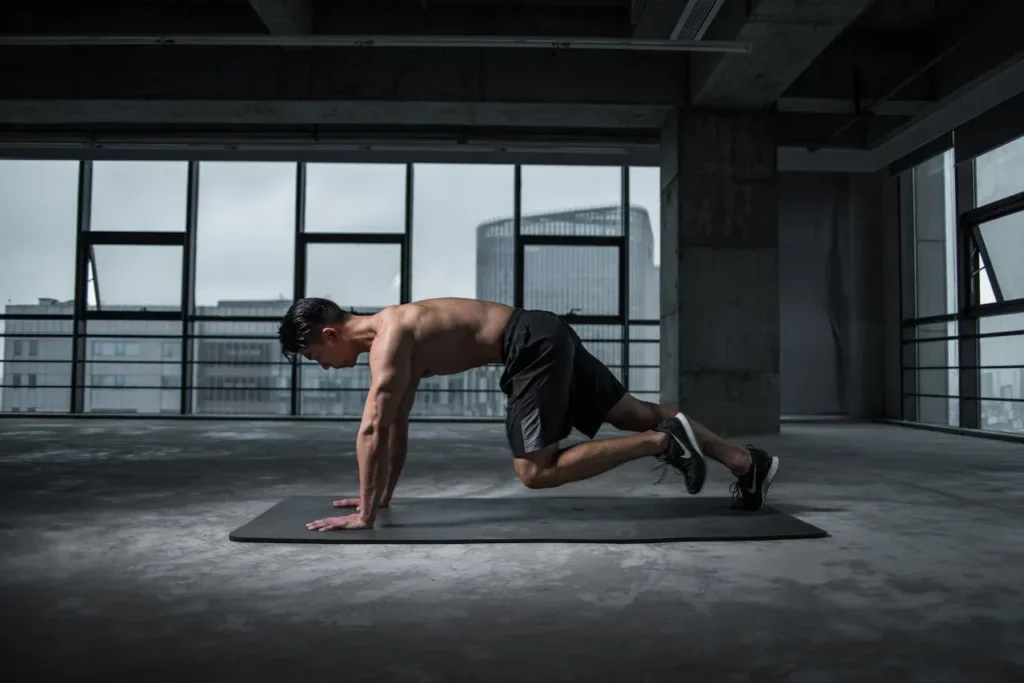
7. Glute Bridges
Glute bridges are excellent for strengthening the glutes, hamstrings, and lower back. They also engage the core and improve hip mobility. Glute bridges are fundamental bodyweight exercises for anyone looking to enhance their lower body strength.
How to Perform a Glute Bridge:
- Lie on your back with your knees bent and feet flat on the floor.
- Push through your heels to lift your hips towards the ceiling, squeezing your glutes at the top.
- Lower your hips back to the starting position.
Benefits:
- Strengthens the glutes and hamstrings.
- Improves hip mobility and lower back strength.
- Engages the core for stability.
Tips:
- Keep your feet hip-width apart and close to your glutes.
- Squeeze your glutes at the top of the movement.
- Avoid arching your lower back.
Variations:
- Single-Leg Glute Bridge: Perform the bridge on one leg to increase the challenge.
- Bridge March: Alternate lifting each leg while holding the bridge position.
- Elevated Glute Bridge: Place your feet on an elevated surface for added difficulty.
🔁 Progression Tip: Start with 2 sets of 10–15 reps, focusing on glute activation. Progress to single-leg bridges or elevated feet once you can hold the top position for 3–5 seconds with control. Add a march or pulse for extra challenge.
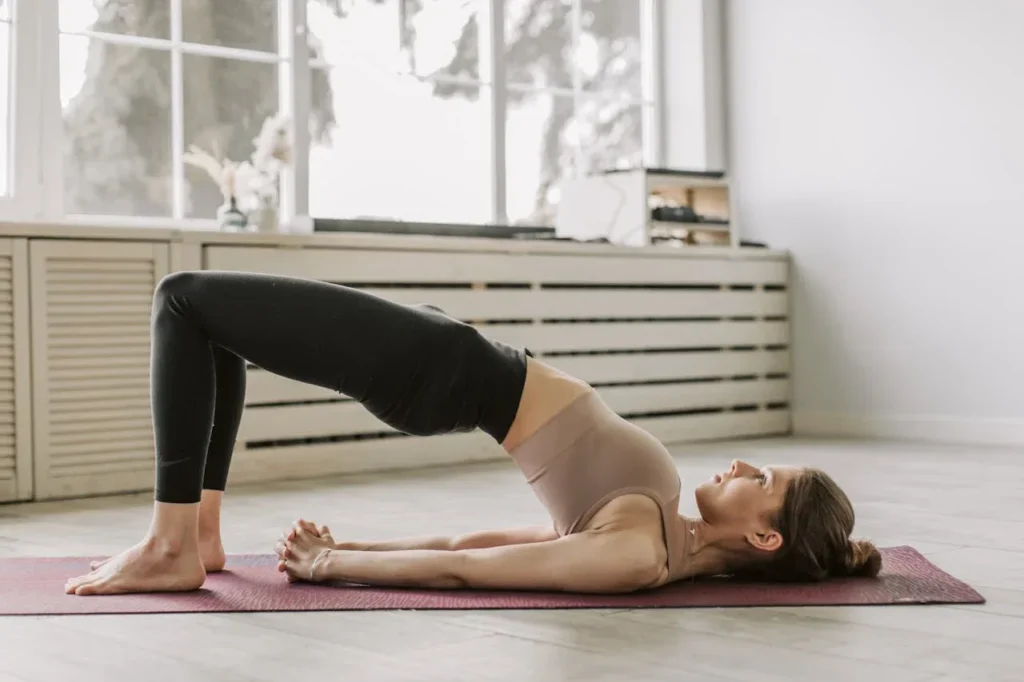
🗓️ Sample Bodyweight Workout Plan (Visual Chart)
| Day | Focus | Exercises | Sets x Reps | Goal |
|---|---|---|---|---|
| Monday | Full Body Strength | Push-Ups, Squats, Glute Bridges | 3–4 sets x 8–12 reps | Build foundational strength |
| Tuesday | Core & Stability | Planks, Mountain Climbers | 3–4 sets x 30–45 sec each | Core control & endurance |
| Wednesday | Rest or Active Recovery | Light walk, stretching, or yoga | — | Recovery and mobility |
| Thursday | Lower Body Focus | Squats, Lunges, Glute Bridges | 3–4 sets x 10–15 reps | Strength and balance |
| Friday | Conditioning | Burpees, Mountain Climbers, Planks | 3 rounds, 30 sec each, 15 sec rest | Cardiovascular endurance |
| Saturday | Upper Body + Core | Push-Ups, Planks, Glute Bridges | 3 sets x 10 reps or 30 sec holds | Upper body strength and stability |
| Sunday | Rest | — | — | Full recovery |
📝 Tip: Adjust reps or increase intensity weekly to apply progressive overload. For beginners, reduce sets or reps. For advanced, increase reps or time under tension.
Conclusion: Bodyweight Exercises
Incorporating these seven bodyweight exercises into your fitness routine can significantly improve your strength, flexibility, and overall fitness. They are versatile, require no equipment, and can be modified to suit any fitness level.
By regularly practicing these exercises, you’ll be well on your way to achieving your fitness goals. Remember to listen to your body, focus on proper form, and gradually increase intensity as you progress. Happy training!
🔥 Gear to Help You Achieve Your Health and Fitness Goals 💪
If you’re looking for tools to enhance your fitness journey, check out this. Explore top-rated fitness gear on Amazon to enhance your workouts. Check out the latest picks here! 🛒 to support your workouts and progress.
🚀 Find equipment designed to boost strength, endurance, and overall performance!
⚠️ Short disclaimer: As an Amazon Associate, I earn from qualifying purchases.
💬 Bodyweight Exercises FAQ
1. Can beginners start with bodyweight exercises?
A: Yes. Bodyweight exercises are ideal for beginners because they require no equipment and scale easily to any fitness level. Starting with basic movements like wall push-ups or chair squats builds strength safely and progressively.
2. Do bodyweight exercises build real muscle?
A: Absolutely. Bodyweight training builds muscle through progressive overload—by increasing reps, tempo, or difficulty. Exercises like push-ups, squats, and planks activate major muscle groups and stimulate growth without weights.
3. How often should I do bodyweight workouts?
A: Most people benefit from 3–5 sessions per week. Beginners can start with 2–3 full-body workouts, while advanced trainees may train daily with varied intensity. Consistency and recovery are key to long-term progress.
4. Are bodyweight exercises safe for older adults?
A: Yes. Bodyweight exercises are joint-friendly and easily modified for seniors. Movements like glute bridges, wall push-ups, and chair squats improve strength, balance, and mobility without stressing the joints.
5. What are the main benefits of bodyweight training?
A: Bodyweight training builds strength, mobility, and endurance using your own body as resistance. Key benefits include:
- No equipment required
- Scalable to any fitness level
- Improves joint health and posture
- Enhances real-world functional strength
6. How do I make bodyweight exercises harder over time?
A: You can increase difficulty by:
- Adding reps or sets
- Slowing tempo for more time under tension
- Using harder variations (e.g., decline push-ups, pistol squats)
- Reducing rest time between sets
7. Do I need a split routine for bodyweight workouts?
A: Not necessarily. Full-body workouts are great for beginners and busy schedules. As you progress, split routines like push/pull/legs or upper/lower can help target specific muscle groups and improve recovery.
8. What if I have joint pain or limited mobility?
A: You can still train safely with modified bodyweight exercises. Choose low-impact movements like wall push-ups, seated leg lifts, or glute bridges. Focus on control, range of motion, and avoid exercises that cause discomfort.
9. Can I combine bodyweight exercises with walking or other cardio?
A: Definitely. Bodyweight training and cardio complement each other beautifully. Walking, hiking, or cycling boosts heart health and endurance, while bodyweight exercises build strength and mobility. You can alternate days or combine them in the same session—like a 20-minute walk followed by a quick push-up and squat circuit. The key is consistency and listening to your body.
10. What if I get bored doing the same bodyweight routine?
A: Boredom is a sign it’s time to mix things up. Try new variations (like decline push-ups or jump squats), change your workout structure (EMOMs, circuits, ladders), or train in a new environment—outdoors, at a park, or even in your van. You can also set mini-challenges: 100 push-ups a day for a week, or a 30-day plank streak. Progression isn’t just physical—it’s mental too.
🚀 Ready to Build Real Strength with Zero Equipment?
If today’s bodyweight exercises got you moving, there’s even more waiting for you. Dive into The Ultimate Calisthenics FAQ for a complete guide to bodyweight training—covering technique, progression, recovery, and common mistakes.
And if you’re looking for routines designed to support older adults, the Senior Fitness: 15 Essential Principles post offers safe, empowering strategies to help you stay strong, mobile, and confident.
Your next milestone starts now.
And let us not grow weary while doing good, for in due season we shall reap if we do not lose heart. – Galatians 6:9

